 The Rock Island Armory XT series of pistols have opened the door to inexpensive, reliable, and fun shooting 1911-based pistols intended for target shooting, competition, plinking rounds, defensive work, and hunting rodent-like animals. Three versions are available: XT 22 Standard – 22LR (Model 51830), the XT 22 Standard Combo 22LR/.45ACP (Model 51937), and the XT 22 Magnum – 22 Magnum (Model 51996).
The Rock Island Armory XT series of pistols have opened the door to inexpensive, reliable, and fun shooting 1911-based pistols intended for target shooting, competition, plinking rounds, defensive work, and hunting rodent-like animals. Three versions are available: XT 22 Standard – 22LR (Model 51830), the XT 22 Standard Combo 22LR/.45ACP (Model 51937), and the XT 22 Magnum – 22 Magnum (Model 51996).
Since I have a few Rock Island Armory .45ACP pistols, I decided that the basic, XT 22 Standard – 22LR (Model 51830) would be an excellent opportunity to see if the XT 1911 would hold up to the quality standards of its full-caliber brethren.
Why another .22 caliber pistol? Armscor has introduced its propriety 22 TCM in pistol and long gun platforms, and also a .22 Magnum 1911-based pistol. The XT 22LR just seemed to be more of a fit in my family of .22 caliber handguns. Whether the RIA XT 22LR would be an adequate fit, remained to be seen, and you have to have one in order to truly evaluate one.
Reviews on the RIA XT 22LR are far and few between. Plenty has been written and videoed on the 22 TCM and XT 22 Magnum pistol, but very little exists in the way of reviews specific to the RIA XT 22LR.
First of all, let’s start with some basic information about the RIA XT 22 and go from there. I guarantee you that you are going to get as complete a written review of the XT 22LR pistol as I can provide. I don’t get paid by the word for doing this. In fact, I don’t get paid at all, which means that I can be as glowing or as critical as I need to be.
THE BASICS:
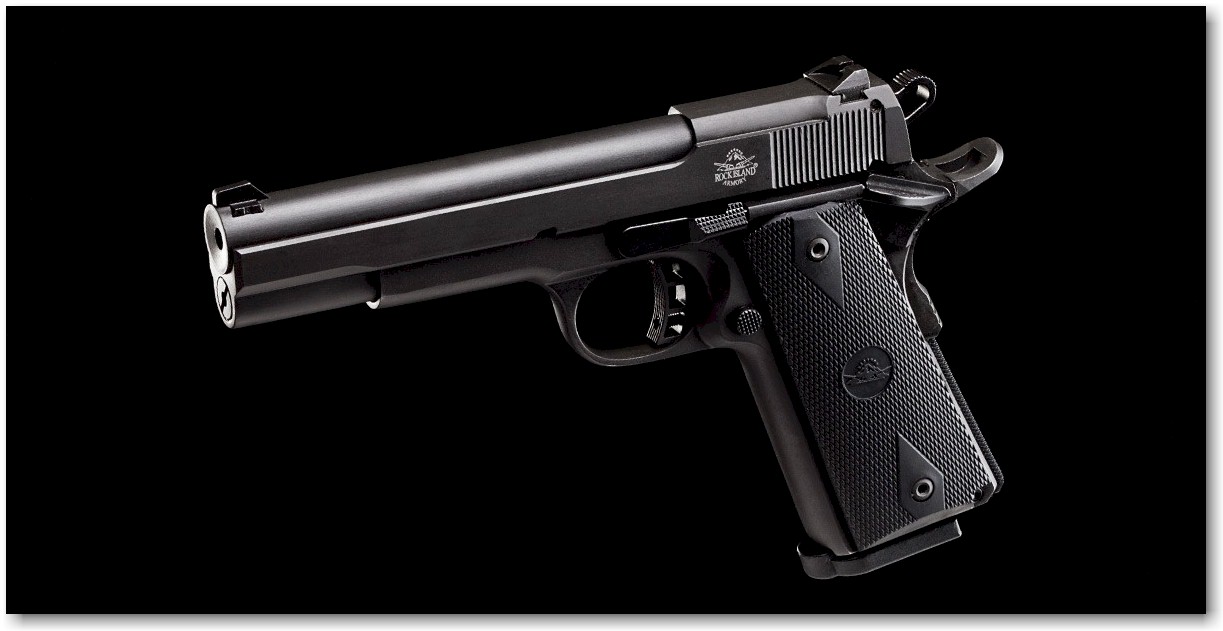
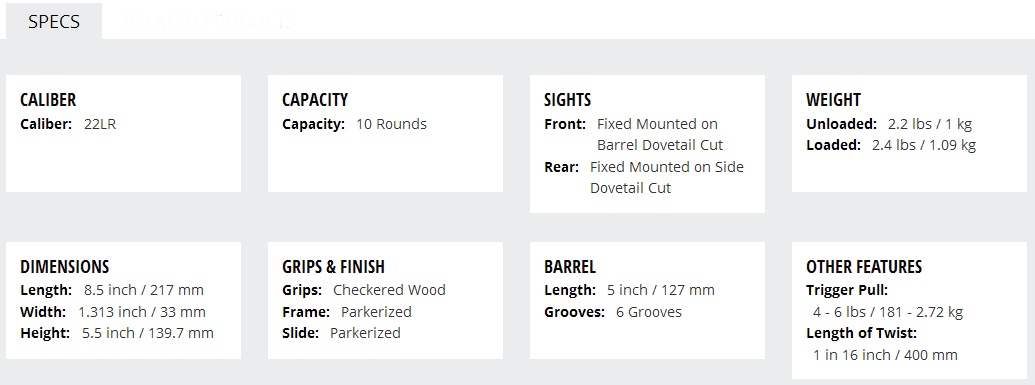
The XT22 pistol is built on a 1911 platform designed and chambered to handle the smaller and more economical .22LR cartridge.
This pistol uses the frame assembly of the 1911A1 model and incorporates a fixed bull barrel with a solid integral lug for optimal stability, breech mounted ejector arm and feed ramp, and a modified slide open at the top and with a firing pin function suited for a cal .22LR rimfire cartridge.
Dovetailed front sight is fixed on the barrel for the standard model while a picatinny rail block is attached for the target model in place of the front sight. Except for the modified barrel, slide and bottom lug cavity on bridge of frame, there is no fundamental difference in the principle of operation with other RIA 1911 pistols.
All parts are made of high ordnance steel, CNC-machined to equally-consistent dimensions to ensure mechanical efficiency, long life and complete parts interchangeability, and heat-treated for strength and durability.
WHAT’S IN THE BOX:
 The RIA XT 22Lr comes in the usual Rock Island Armory hard-shell plastic case with foam-padded interior cut out so as to accommodate the pistol and spare magazines. Snuggled in the main compartment was the XT 22LR nicely wrapped in protective plastic. Also included is the documentation and two expended casings – proof that the pistol had been fired.
The RIA XT 22Lr comes in the usual Rock Island Armory hard-shell plastic case with foam-padded interior cut out so as to accommodate the pistol and spare magazines. Snuggled in the main compartment was the XT 22LR nicely wrapped in protective plastic. Also included is the documentation and two expended casings – proof that the pistol had been fired.
I had ordered the RIA XT 22LR and two spare magazines. When the package arrived, the pistol was inspected and deemed worthy of purchase, the necessary paperwork was completed, funds exchanged hands, and I was the legal owner of the Rock Island Armory.
THE REALITY:
I have a German Sport Guns GmbH (GSG) 1911-22 that has been shot a few times, cleaned, and then put away into some hidden recess in the safe. While the GSG 1911-22 seems to be a good pistol, it is priced far less than the RIA XT 22, but has one caveat when field stripping the pistol that I don’t care for, even though I know the reason for the caveat. I have also handled the Walther Colt Government Model 22, the Sig Sauer 1911-22 (made by German Sport Guns GmbH (GSG) 1911-22, incidentally), and the Chiappa 1911 22. The RIA XT 22LR has, in my opinion, several advantages over other 1911-based .22 caliber pistols. With that said, the RIA XT 22LR also has a quirk regarding assembly from a field stripped condition, which I will get into later.
- The slide and frame are 4140 Ordinance Steel rather than an aluminum alloy slide and zinc alloy frame like the GSG 1911 22, Sig Sauer 1911-22, and the Walther/Colt 1911 22.
- All frame components are standard 1911-part compatible.
- Aside from the upper (barrel and slide components), disassembly and assembly is identical to a standard 1911.
- A 70-Series .45ACP upper (slide, barrel, recoil spring and guide, barrel and recoil spring plug) can be installed on the frame and fired. (Note that the XT 22LR is simply one-half of the XT 22LR/.45ACP combination package.)
My understanding is that Armscor spent two years developing this pistol. So, let’s see how they did.
Aesthetics:
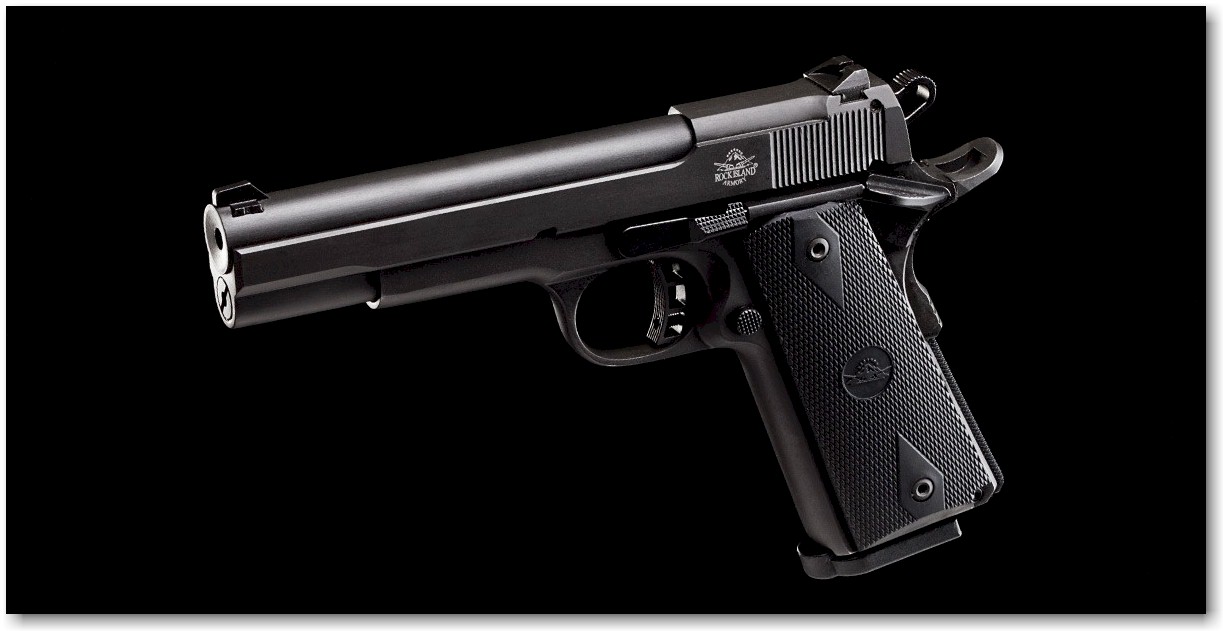 Beauty is in the eye of the beholder, as they say. Some 1911 purists would say that a .22 caliber pistol should be something other than a 1911-based design. Personally, I have no problem with surrounding a .22 caliber cartridge with a 1911-based pistol – as long as it works.
Beauty is in the eye of the beholder, as they say. Some 1911 purists would say that a .22 caliber pistol should be something other than a 1911-based design. Personally, I have no problem with surrounding a .22 caliber cartridge with a 1911-based pistol – as long as it works.
At first glance the RIA XT 22LR looks like any other 1911-based pistol on the market today – until you glance at the slide and figure out that some of the slide isn’t present. From just forward of the chamber, the top of the slide has been removed for weight savings and reliable functioning.
Surprisingly; however, the slide and barrel design actually blends well with the frame of the pistol and is somewhat reminiscent of the CZ-75 in that the slide gives the impression that it is lower on the frame than it actually is. The XT 22LR offers a sleek looking appearance and the 5-inch barrel just aids in the sleek look.
The Parkerized finish looks excellent, and thankfully, the RIA logo is minimally-applied on the left side of the slide.
The front end, of course, is different than you would find on a standard 1911; there is no barrel bushing. A slotted, screw-in cap (Recoil Spring Plug, Part # 2416A) with a hole in the center serves as a loosely-fit Guide Rod bushing. Elsewhere, the RIA XT 22LR looks and functions like a 1911-based pistol.
Overall, I find the RIA XT 22LR pleasing to look at. There are no additional pins, screws, or key-locks to distract from its appearance.
The Slide and Barrel:
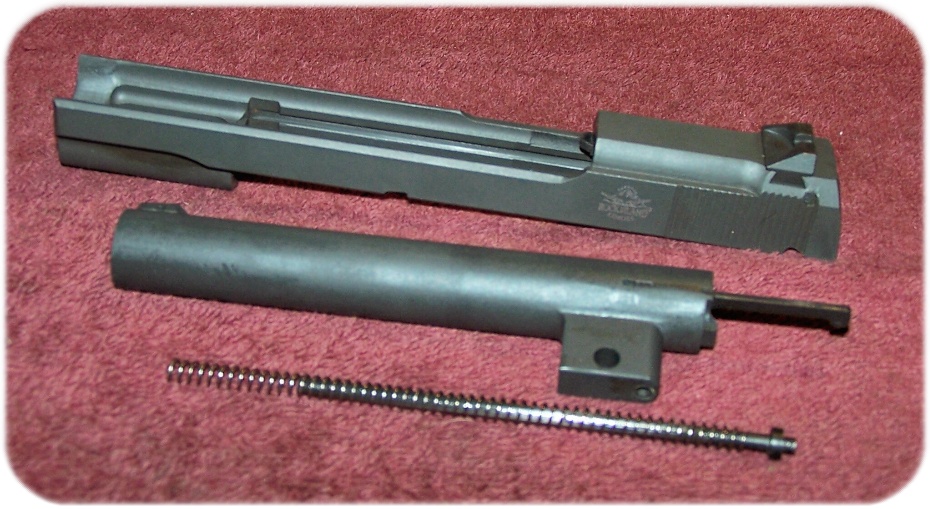 All Rock Island Armory 1911 pistols are built from 4140 Ordinance Steel, and the XT 22 is no exception. The simple blow-back operation of the XT 22 brings with it challenges in supporting the barrel while ensuring some degree of accuracy out of the pistol. In that respect, RIA has answered the call through a unique barrel design that incorporates a pin (the standard 1911 take-down pin) to secure the barrel and also a guide (the Ejector) that slides within the upper part of the slide assembly. Using this barrel mounting system allows the user to remove the upper (slide and barrel assembly) from the pistol just like any 1911-based pistol.
All Rock Island Armory 1911 pistols are built from 4140 Ordinance Steel, and the XT 22 is no exception. The simple blow-back operation of the XT 22 brings with it challenges in supporting the barrel while ensuring some degree of accuracy out of the pistol. In that respect, RIA has answered the call through a unique barrel design that incorporates a pin (the standard 1911 take-down pin) to secure the barrel and also a guide (the Ejector) that slides within the upper part of the slide assembly. Using this barrel mounting system allows the user to remove the upper (slide and barrel assembly) from the pistol just like any 1911-based pistol.
The slide is cutout to reduce weight. Unfortunately, this is a must (unless aluminum alloy is used for the slide material) to accommodate the light recoil of the .22LR cartridge. This cutout gives the XT 22LR a “Beretta” look, as found in the Beretta Model 92 and other Beretta pistols.
The barrel actually consists of four parts; Barrel (2201R), Front Sight (4513A), Ejector (2243), and Barrel Lug Adjusting Screw (MIG003).
The front sight is dovetailed into the barrel. I have a concern about inherent accuracy with this type of sighting arrangement, but I talk more about that in RANGE TIME. The rear sight is a dove-tailed “Novak” low-profile style sight with a simple notch.
The RIA XT 22LR actually has two ejectors; one is positioned on the frame where you normally find a 1911 ejector, and the other ejector is integrated into the .22 caliber barrel.
The barrel “assembly” is “cradled” in the slide, which gives the impression of an “open-top” design like the Beretta. Unlike the Beretta; however, there is no “frame” upon which to mount the front sight. The barrel is fixed into place within the frame by the Take-Down Pin. If the barrel moves, the front sight moves. Does the barrel move? I’ll get into that shortly.
The Barrel Lug Adjusting Screw (Part MIG003) adds a bit of fascination to the barrel’s design and is worth a mention or two. To mitigate the barrel from moving, RIA has included in the barrel design a component referred to as the Barrel Lug Adjusting Screw (Part MIG003). The Barrel Lug Adjusting Screw is screwed into the barrel lug from the bottom. Its purpose is to prevent the barrel from just flopping around vertically on its axis; the Takedown Pin. By comparison, the GSG 1911-22/Sig Sauer 1911-22 uses a “Barrel Fixing Pin” that is inserted into the left side of the frame just rearward of the Slide Lock pin and is inserted through the Barrel Lug. A hex head screw is inserted into the right side of the pistol just forward of the Slide Lock pin and tightened into the barrel lug to prevent the barrel from pivoting. Unlike the XT 22LR that has the barrel lug screw integral to the barrel lug, the “Barrel Fixing Pin” and hex-head screw of the GSG 1911-22 must be removed to field strip the pistol. The RIA XT 22LR is a definite improvement over the GSG/Sig Sauer 1911-22 design and provides for more of a “conventional” 1911 field stripping.
The feeding end of the barrel is a polished feed ramp. It is recommended, by Armscor, to use premium high velocity (1250fps +) .22 LR ammunition for best functioning.
The little exit hole of the barrel is inset and protected by a nicely-formed crown of protection. While the muzzle end of the barrel is fascinating, what is more fascinating is how the barrel interacts with the slide, which in turn, interacts with a normal and full-sized 1911 frame. But, is all what it seems to be?
What has to be remembered is that, unlike the J.M Browning swing-link design of the 9mm and .45ACP version of the 1911, the barrel of the XT 33LR (and XT 22 Magnum) is fixed; only the slide moves and not the barrel and slide. As previously mentioned, the barrel of the XT 22LR includes the ejector, although the normal 1911 ejector is also present in the frame – pinned as is normal to the 1911 design.
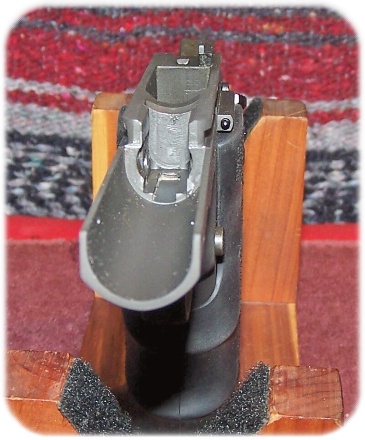
Frame Showing Cut-Out for XT 22LR Barrel
The lug of the barrel fits down into the “Locking Well” that is the same as with the standard swing-link 1911 design. The difference; however, is that the “Locking Well” is cut deeper on the XT 22LR to accommodate the longer barrel lug. This, in itself, is the reason why you could not take a standard 1911 frame and install the XT 22LR upper onto it, even if you were thinking about doing that, without an extreme amount of mill work. It would be cheaper just to buy the RIA XT 22LR.
What it does mean; however, is that you could (theoretically) take a 1911 45ACP complete upper assembly (slide, barrel, etc.) and use it with the XT 22LR frame. In fact, that is what Armscor does with the XT 22/45 ACP Combo package. I have more on this later in the write-up.
With the slide in full battery, and a round chambered, the spring-loaded external extractor wraps its little claw around the rim of the cartridge. Upon firing the cartridge, the barrel stays in place while the slide moves rearward under recoil and pulls the expended cartridge with it. The ejector, which is integral to the barrel, catches the base of the cartridge, releases it from the extractor, and ejects it (very nicely, I might add) out and away from the pistol. The ejector rides within the slide by way of the ejector channel.
While bracing the pistol, I tried to move the barrel with my finger as I slowly pulled the slide to the rear. There is a little barrel free-play when in full recoil. However, this also aids in chambering a fresh round, especially one as small as the .22LR cartridge. In full battery; however, the barrel is surprisingly stable with a little side-to-side play. If you don’t expect tack-driving accuracy out of this pistol, you will not be disappointed. With that said, accuracy is better than I expected out of it.
The guide rod (Recoil Spring Guide, Part #2217A) is a full-length unit with a non-captivated Recoil Spring (Part #2215). The guide rod base is inserted into a hole in the front of the barrel lug. While this arrangement adds no difficulty in removing the barrel from the slide, it does add a wee bit of complexity when assembling the barrel to the slide, and I bring this out in Assembly (Field Strip Level). The Recoil Spring, according to Armscor, is in the 7-8 pound range.
The XT 22 sighting system is the basic post and notch arrangement. The front and rear sight is mounted in dovetail slots that are machined into the barrel and slide, accordingly. The rear sight is a “Novak-style” sight in that it mimics the Novak design with its “snag-free” design. With the exception of the “Government” models, the front sight is the same style as found on all RIA 1911 pistols.
The barrel and slide have received a Parkerized finish that appears to be more than adequately applied.
Dimensionally, the slide width is the same as that found on full-size 1911-based pistols.
The rear of the slide is outfitted with fine serrations to provide a good purchase on the slide, not that you actually need then as the slide is very easy to operate. On the left side of the slide, just before the serrations, you will find the Rock Island Armory logo. I am happy to see RIA do away with their “bill-boarding” of the slide.
The slide assembly also incorporates the firing pin and extractor. The spring-loaded extractor is external to the slide and held in place by a roll-pin. The spring-loaded firing pin is also held in place by a removable roll-pin, which not only keeps the firing pin from flying out the rear of the slide but also prevents the tip of the firing pin from protruding too far into the face of the bolt after being struck by the hammer. For those who are interested, the firing pin does not protrude past the thickness of the .22 caliber base. I did dry-fire the pistol without a “snap-cap” in place and did not detect any marking on the chamber end of the barrel. I suspect the “dry-fire” warning is targeted to possible damage to the Firing Pin Stopper Pin (Part #MIG028) rather than damage to the breech face.
It is advised to refrain from a lot of dry-firing the pistol. Like the Ruger rimfire designs, which prevent the firing pin from striking the breech face, the XT 22 is similar in principle. It should be noted that that slide does not remain open on the last round, which makes dry firing the pistol inevitable. I would recommend “snap caps” for dry fire “practice” to help mitigate possible damage to the firearm. I would not; however, recommend plastic “snap caps” for dry firing unless you feel like pushing the remnants of the plastic “snap-cap” out of the chamber from the muzzle end.
Since the slide does not lock back on the last round fired from the magazine, and if you are not counting rounds, the pistol will be dry-fired after the last round. With that said, it puts the XT 22LR in the same league as many other rimfire firearms.
The Frame:

Frame Showing Cut-Out for XT 22LR Barrel
The frame, like the slide, is manufactured from 4140 Ordinance Steel. Dimensionally, it is the same as that found on full-size RIA 1911-based pistols in .45ACP, which means that the XT 22 has not been “down-sized” to accommodate the .22LR cartridge. There is one thing; however, that sets the RIA XT 22LR’s frame apart from some “standard” 1911-based pistols; The RIA XT 22LR uses the “Series 70” convention in its design; a hammer block safety is not incorporated, and a whole lot of 1911 lovers, including me, like it that way.
As was explained in The Slide and Barrel, the barrel locking well is cut deeper than in standard 1911 frames. This deepened “Locking Lug Well” allow you to run a complete .45ACP upper assembly on the XT 22LR frame. However, a complete XT 22LR upper cannot be run in a standard 1911 frame.
The frame incorporates the same safety features as its full-size brethren; grip safety, left-side thumb safety (Note that there is no right-side thumb safety), disconnector, inertia firing pin, and half-cock notch in the hammer (although most don’t consider the half-cock notch in a 1911 a full safety). As noted by Armscor; “The Half-notch is intended to stop the hammer from reaching the firing pin in the unlikely event the full-cock notch fails to hold the hammer back. Should the hammer fall to the half-cock notch, the sear is then captured by the half-cock notch so that the sear can no longer be moved by the trigger until the malfunction is corrected.” Note that the RIA XT 22LR is based on the “70 Series” of 1911 pistols.
Dimensionally the same as the standard “Government/Commander” grip, the grip panels can be exchanged for grip panels according to your liking. The grip panel screws are “hex-head” and are excellent, in my opinion.
My particular XT 22 came with checkered rubber grip panels. While the stock grip panels are more than adequate for most, I exchanged them with a Hogue Rubber Wraparound Grip with Finger Grooves, which made the pistol more compatible (in feel) with my other 1911-pistols.
The frame, not unlike other RIA 1911-based pistols, is equipped with a more than substantial beaver-tail safety with memory bump, a slightly extended thumb safety, extended and checkered slide stop lever, roiled “Commander-style” combat hammer, and checkered flat nylon mainspring housing. The front of the grip is smooth with no undercut. If you have held a full-size 1911 frame, you will feel no difference, because there is no difference; you are holding a full-size 1911-based frame. I noted one occurrence during the range session where I had not fully pressed the grip safety and the trigger could not be pulled. The mistake was in my thinking that I could hold the grip a lot lighter than with a standard 1911. While I can hold the grip lighter than a standard 1911 pistol, too light is not good. The grip safety must be fully pressed to work as it should.
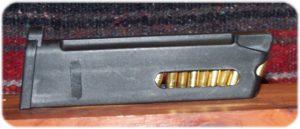
Polymer 10-Round Magazine
The magazine release button is on the usual left side only position and is extended and serrated. The XT 22 comes with one 10-round magazine which slides in and out of a beveled magazine well in fine fashion. The XT 22LR comes with two 10-round magazines. Magazines for the XT 22LR are approximately $23 to $25 online, and you should do a search for best pricing. The magazine is reinforced polymer but seems to function fine. A few spares might be handy (I ordered two spare magazines with the pistol). A big shout out to RIA for not incorporating a magazine disconnect safety feature! I did notice that one of the spare magazines that I purchased rubbed enough inside the frame that it would not release completely without pulling the magazine out of the magazine well. I determined that there was a high spot on the spine of the magazine and some light work with a 600 Emory cloth took care of that issue. The magazines can be disassembled for maintenance.
The trigger is steel and skeletonized with an over-travel adjustment screw. Unless there is an issue with the pistol, I normally leave the over-travel screw as is. I have had one occasion where I had to blue Lock-Tite an over-travel screw. Over-travel is adjusted at the factory, but every now and then one might slip through the cracks. My XT 22 was not one of those; however, and the over-travel adjustment was perfect.
Armscor states that the triggers on their 1911-based pistol weight in between four and six pounds. The one thing that I can say about the triggers on the Rock Island Armory 1911-based pistols is pretty consistent. The trigger pull weight on my particular XT 22 was a 4.02 pound average out of the box. There is a slight take-up, but the break is clean, and I can’t ask for more than that out of a production pistol. Trigger reset is typical of that found on most 1911-based pistols. Since the frame is a 1911-based pistol, this was to be expected.
It is important to note that the frame allows the use of standard 1911 parts. Customization, then, is really up to your whim and whimsy – as far as the frame is concerned. However, be advised that the addition of after-market parts will void the warranty (I am sure that excludes the grip panels).
THE WEIGHT OF IT ALL:
Aside from the obvious difference in the slide and barrel for the XT 22, there is the difference in weight between the XT 22 and its full-sized brethren; the .45ACP.
The XT 22LR weighs in at 2.4 pounds (38.4 ounces) loaded. The full-blown .45ACP version (1911 FS “Rock” Standard) weighs in at 2.87 pounds (45.92 ounces) loaded. That is only a difference of .47 pounds (7.52 ounces). That difference actually puts the XT 22 in the same league as a loaded “Commander” 1911 in .45ACP. Essentially, the XT 22 is a heavy pistol given the round it fires. However, lest we forget, the frame can also accommodate an “upper” for a full-blown .45ACP. What results is a very low recoil .22LR 1911-based pistol that you can easily upgrade.
MAINTENANCE:
 Before I go into this review, there is one caution that must be mentioned. You are working with something that is under spring tension; the recoil guide and spring. The recoil guide and spring, if not controlled properly when removed and installed, can fly enormous distances. Always wear eye protection devices when working with items under spring tension! Always release items that are under spring tension slowly! With that said, I can continue with a clear conscience.
Before I go into this review, there is one caution that must be mentioned. You are working with something that is under spring tension; the recoil guide and spring. The recoil guide and spring, if not controlled properly when removed and installed, can fly enormous distances. Always wear eye protection devices when working with items under spring tension! Always release items that are under spring tension slowly! With that said, I can continue with a clear conscience.
Disassembly (Field Stripping My Way):
- Ensure that the pistol is not loaded. Press the magazine release and withdraw the magazine. Pull the slide backwards and check the chamber to ensure that the pistol is unloaded and safe.
- Pull or push the slide backwards until the shallow notch on its left aligns with the top rear of the Slide Stop.
- Remove the Slide Stop. Press the Slide Stop pin on the right side of the frame to push the Slide Stop clear of the frame, and then pull out the Slide Stop from the left side of the frame.
- Slowly remove spring tension from the slide by allowing the slide to slowly move forward.
- Pull the complete slide assembly directly forward off the frame.
- Set the frame aside.
- Place the complete slide assembly on a soft working surface with the top of the barrel facing down.
- Support the front of the slide with one hand while grasping the Recoil Spring and Recoil Spring Guide with the other hand.
- Caution! The Recoil Spring is under tension. Push (or pull depending upon which you prefer) the Recoil Spring and Recoil Spring Guide to disengage the recoil spring guide from the barrel lug cavity. The barrel will fall free from the slide, at this point.
- Slowly release tension on the Recoil Spring.
- Remove the Recoil Spring and Recoil Spring Guide from the pistol.
- Decide if the Recoil Spring Plug is to be removed from the pistol. Update Note: Due to owners’ damaging the Recoil Spring Plug threads upon assembly, or not tightening the Recoil Spring Plug properly (where the Recoil Spring Plug actually loosens during the firing of the pistol, Armscor has opted to use Lok-Tite on the screw threads in later models (I explain this in Part 3 of the review). If you can remove the Recoil Spring plug, continue to the next step. Otherwise, this completes the disassembly procedure.
- If the Recoil Spring Plug is to be removed from the pistol, continue to Step 13.
- If the Recoil Spring Plug is not to be removed, this ends the field stripping procedure. (See, Assembly (Field Strip Level) Assembly Procedure #2 – Recoil Spring Plug not removed During Disassembly before you decide to do this.)
- Optional: Using a suitable flat-tip screwdriver, remove the Recoil Spring Plug from the front of the slide.
Cleaning and Lubrication:
General care should be taken to ensure that no lubricant is present on the bolt face, firing pin, or firing pin channel.
As for lubricant, I use Lubriplate NO. 130-A, but your choice of lubricants may vary.
A light bit of lubricant is used on the frame rails.
A light coat of lubricant should be used on the under side of the barrel where it makes contact with the slide.
Since the ejector rail also contacts the slide, I decided on a very thin layer of lubricant on the contact points within the slide.
If you have removed the Recoil Spring Plug, lightly lubricate the threads of the plug. The plug is finely threaded and a little lubrication helps in removing and installing the plug. I also put a thin layer of lubricant around the hole of the Guide Rod Spring Plug.
Now, some may say that I am over-lubricating, and especially with a .22 rimfire semi-automatic pistol. I do a through cleaning of my firearms after a shooting session and I would rather have the firearm suitably lubricated during the range session than not. With that said, I do not internally lubricate the frame’s action components. A soft, coned-shape bristle-brush usually takes care of any build-up in the mag-well.
Assembly (Field Strip Level):
The User’s Manual, simply states to reverse the disassembly procedure to assemble the firearm. I hate when they do that. From my perspective, there are two ways to assemble the pistol from a field-strip. I do find it ironic; however, that the User’s Manual provides instructions for completely disassembling and assembling the entire frame, a far more complex procedure than field stripping, but did not include step-by-step instructions for assembling the pistol from a simple field stripping.
I am going to present two assembly procedures and let you decide which procedures works best for you if or when you decide that you might like the RIA XT 22LR (or other XT pistols).
- If you have removed the Recoil Spring Plug, proceed to Assembly Procedure #1 – Recoil Spring Plug Removed During Disassembly.
- If you have not removed the Recoil Spring Plug, proceed to Assembly Procedure #2 – Recoil Spring Plug not removed During Disassembly.
Assembly Procedure #1 – Recoil Spring Plug Removed During Disassembly:
The procedure that follows assumes that you have removed the Guide Rod Spring Plug from the firearm.
Required Tools: You will need a notched flat-tip screwdriver bit, a “Spanner” bit, or a small flat tip screwdriver with a tip just wide enough to fit between the guide rod and the outer edge of the Recoil Spring Plug. Personally, I prefer the “Spanner” bit.
Author’s Note:
A “Spanner” bit is a type of security screwdriver bit. Spanner bits can be purchased on-line in sets or individually. I do recommend bits suitable for gunsmithing work to help prevent the bits from slipping and marring of surfaces.
- With the top of the slide facing upward, insert the barrel onto the slide. Insert the rear of the barrel first and then let the barrel rest against the slide at the front.
- While holding the barrel and slide together, flip the barrel and slide over and place them against a soft surface.
- Insert the Guide Rod assembly into the slide from the front. Ensure that the base of the Guide Rod is toward the rear of the slide.
- Insert the base of the Guide Rod into the well that is located on the front of the barrel block.
- Position the slide so that you can compress the Guide Rod Spring.
- Using the thumb and forefinger, squeeze the Guide Rod Spring and pull it to the rear enough to clear the front of the slide.
- Install the Guide Rod Spring Plug. Carefully screw the Guide Rod Spring Plug into the slide (Caution: Ensure that you do not cross-thread the threads on the slide or Recoil Spring Plug.) until the Guide Rod aligns with the hole in the Guide Rod Spring Plug.
- When the Guide Rod is captured by the Guide Rod Spring Plug, slowly release the pressure on the Guide Rod Spring.
- Using a “Spanner” screwdriver bit, or a flat-tip screwdriver that fits between the guide rod and the outer edge of the Guide Rod Spring Plug, tighten the Guide Rod Spring Plug until the tip of the guide rod meets the face of the Guide Rod Spring Plug. Do not over-tighten the Guide rod Spring Plug.
- Install the completed slide assembly onto the slide of the frame until the barrel’s locking block hole aligns with the take-down pin hole in the frame.
- Insert the take-down pin into the frame just enough to engage the hole in the barrel lug
- Position the slide so that disassembly/assembly notch in the slide is aligned with the disassembly/assembly notch in the frame.
- Press the Slide Stop Pin into place in the barrel and frame.
- Slowly release the slide to its full forward (in battery) position.
- Check the pistol for proper and safe operation. To check trigger operation, cock the hammer, and hold the hammer between the thumb and forefinger of one hand to control the descent of the hammer. Engage the grip safety while pulling the trigger with the shooting finger of the shooting hand. Do not allow the hammer to fall freely with no round chambered. Doing so may damage the firearm.
Assembly Procedure #2 – Recoil Spring Plug not removed During Disassembly
The procedure that follows assumes that you have left the Guide Rod Spring Plug in the firearm during the field stripping process.
Author’s Note:
While the procedure that follows may seem complex, it is actually very simple. After performing it two or three times, you will be doing it like a pro before you know it.
Tools Required: Finger dexterity and gripping power, and/or a small but strong spring clamp with rubber-coated clamping tips. (Author’s Note: I have small, rubber-coated spring clamps that work great for this procedure; the Jorgensen 3201-HT 1-Inch Pony Spring Clamp.)
Author’s Note:
I have included, at the end of the article as a pictorial reference, images of the assembly procedure that follows.
- Press the Recoil Spring into the detent in the rear of the Recoil Spring Plug.
- Using one hand to support the slide, and using the thumb and forefingers of the other hand, slowly compress the recoil spring and insert the Guide rod and Recoil Spring assembly through the Guide Rod Spring Plug from inside the slide and from the bottom of the slide. Ensure that you do not kink the Recoil Spring. I have found that 1.5” to 2” of protrusion of the Recoil Spring Guide is sufficient enough for clamping and for the barrel to be installed.
- Using a padded set of small, needle-nosed vice grips or (recommended) a spring-loaded clamp like the Pony 3201 Spring Clamp or similar, clamp and hold onto the guide rod at the front of the slide.
- Position the slide so that the top of the slide is facing up. Note: I rest the rear of the slide on a soft surface to keep as little strain on the Guide Rod as possible.
- Insert the barrel into the slide. Insert the barrel at the rear first to guide the ejector arm into its place within the slide.
- While holding the barrel against the slide, position the slide so that the top of the barrel is facing down. The barrel and slide should now be resting on a soft surface.
- Slowly release tension on the Recoil Spring Guide and guide it into place in the barrel lug. (I have found that if I lay the barrel and slide on a soft surface, I can grasp the base of the Recoil Spring Guide with my thumb and forefinger, which allows me to guide and control the base of the Recoil Spring Guide as I slowly release the clamp’s tension. Since I am right-handed, I release the clap pressure with my right hand – Use whatever hand provides the best control over releasing the Recoil Spring.)
- With the barrel and Recoil Spring Guide assembly properly installed, install the slide onto the frame. Position the hole in the barrel lug to align with the Slide Stop hole in the frame.
- Lightly insert the Slide Stop pin to capture the slide.
- Push the slide rearward until the small disassembly/assembly notch in the slide aligns with the disassembly/assembly notch in the frame.
- Fully install the Slide Stop into the frame.
- Test for proper functioning. Note: It is advised to hold the hammer while pulling the trigger to allow the hammer to slowly fall forward against the firing pin.
RANGE TIME:
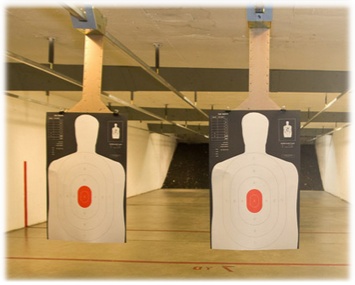 I was definitely interested to see how the RIA XT 22LR was going to perform at the range. In keeping with Armscor’s recommendation for ammunition, some CCI MINI-MAG 36-grain CPHP ammunition that should zing along at about 1260fps should do the trick.
I was definitely interested to see how the RIA XT 22LR was going to perform at the range. In keeping with Armscor’s recommendation for ammunition, some CCI MINI-MAG 36-grain CPHP ammunition that should zing along at about 1260fps should do the trick.
My intent with this range session was to simply bench rest the pistol to establish a POA, shoot for a best group while bench rested, and then move to some free-hand work.
Wrapping my hand around the Hogue Wraparound Rubber Grip with Finger Grooves felt the same as with its big brother, the RIA 1911 FS Tactical. The only thing that did not feel the same was the recoil. Due to the weight of the XT 22LR, recoil was next to nothing.
The sights are simple in nature and I had not yet painted the front sight.
The trigger was excellent at four pounds and I could feel it smoothing out the more the pistol was fired. There was just a hint of take-up and no over-travel. Trigger reset is the same as you would find on any 1911-based pistol.
The XT 22LR shot slightly high to the point of aim at ten yards with CCI Mini-Mag ammunition and several failures were noted with this ammunition. Once chambered, there were no failures to fire. It was getting them into the chamber that seemed to be the problem. All feeding problems indicated that the magazines were at fault. On two occasions, a round nose-dived into the magazine. On another occasion, the follower failed to push the cartridges up the magazine. As the magazines were cycled; however, the issue seemed to go away. Only further shooting will tell. I had no issues with CCI Blazer ammunition. More ammunition will be tested as I move forward with the pistol.
I did notice that the pistol likes chambering when using the Slide Stop as opposed to using the “sling-Shot” method for releasing the slide. But, I find this to be the case with quite a few 1911-based pistols even in full caliber.
I did not expect ‘match-grade” accuracy out of the RIA XT 22LR, but once I settled in with the pistol, accuracy was better than I expected. The front sight definitely needs a dab of paint. At the end of the shooting session, I was able to aim at the “7” on a standard silhouette target and place shots pretty close to it while managing to actually hit the “7” a few times while shooting off-hand at ten yards. For plinking, or for training, the RIA XT 22LR is accurate enough.
THE FINAL TEST:
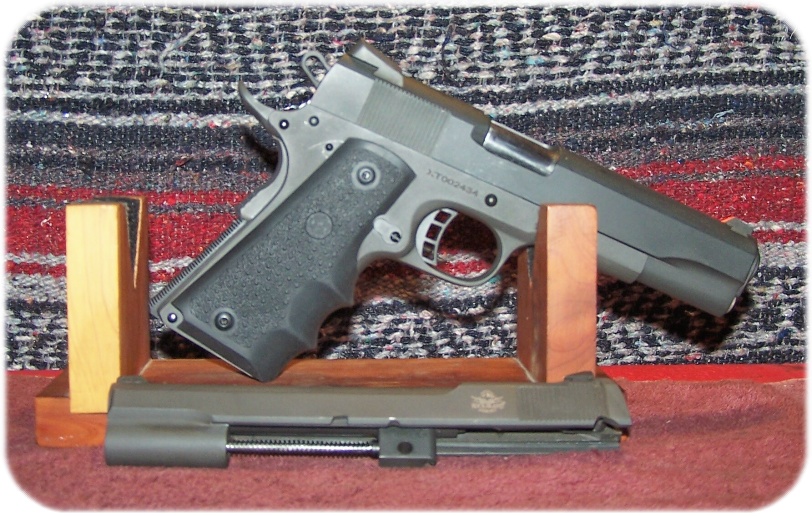
The RIA XT 22LR with .45ACP Upper from a RIA 1911 FS Tactical – Perfect Functioning!
The final test for the RIA XT 22LR pistol was to see if, in fact, a .45ACP slide assembly would not only fit on the frame of the pistol, but would function properly when installed. My usual 1911-based pistol carry is the Rock Island Armory (Armscor) 1911 FS Tactical (2nd Generation). Since I reviewed this pistol (https://guntoters.com/blog/2015/12/05/rock-island-armory-armscor-1911-fs-tactical-2nd-generation-owners-review/), I have exchanged the FLGR with a WILSON COMBAT 1911 Flat Wire Recoil Spring Kit (Standard Guide Rod and #17 FW Recoil Spring) and WILSON COMBAT – 1911 BULLET-PROOF™ RECOIL SPRING PLUG (swirl design). In addition, the grip panels were exchanged for the Hogue Wraparound Rubber Grip with Finger Grooves. It was; however, the complete slide assembly that I was interested in.
To put things into perspective, the RIA XT 22LR/45ACP Combo comes with two slide assemblies. Obviously, these would be the XT 22LR and a .45 ACP slide assembly. I would assume that Armscor mates the two slides to the XT frame. The challenge was to see if the slide assembly from a totally different pistol, although manufactured by Armscor, would fit the frame of the XT without any modifications.
PRODUCT SUPPORT AND CUSTOMER SERVICE:
One of the areas that should concern us is product support, especially when we have a “specialty” firearm of sorts, and the XT 22LR would fall into that classification. Parts for the 1911-based frame are, of course, plentiful and available from a wide range of resources; local gun shops and on-line vendors. Parts for the XT 22LR slide; however, is not available through the Armscor website. There is; however, a associated resource where limited parts can be purchased for the XT22 slide; https://advancedtactical.com/.
I was able to locate; the Recoil Spring, Recoil Spring Guide, and the Firing Pin Spring. I ordered two of the recoil springs and hammer springs (it is usually good practice that when you replace a recoil spring that you also replace the firing pin spring). Note that the Hammer Spring is a standard 1911 part. To replace the Firing Pin Springs; however, the firing pin has to be removed by removing the Firing Pin Retainer Pin, which is not available through the https://advancedtactical.com/ website. Also, the Extractor, Extractor Spring, and Extractor Retaining Pin is not available for purchase. With that said, magazines for the XT22LR are available through https://advancedtactical.com/ and other on-line vendors; shop for the best price.
I will say that Armscor Customer Service did respond to my e-mails in a timely fashion – even if the answers to my questions were not what I wanted to read.
On a side not, Armscor recommends that Wolff springs be used in their firearms. Wolff Springs does not; however, manufacture the recoil spring for the XT22. They did offer to search their database if I provided them with dimensional data to use in a data base search. I did discover, after I submitted such information to them, and in the meantime, that https://advancedtactical.com/ did carry the recoil spring.
TO SHUT IT DOWN:
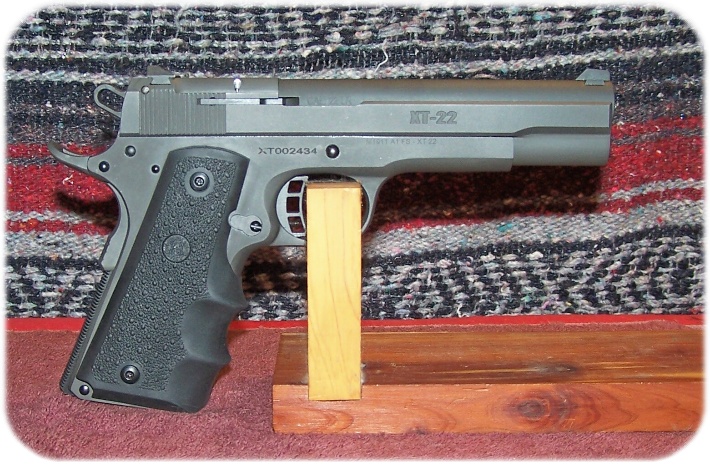
Rock Island Armory (Armscor) XT 22LR with Hogue Wraparound Grips
So, what do I think about the Rock Island Armory XT 22LR? So far, I like it.
It is a little different than other 1911-based .22 caliber pistols; it is heavier, it feels good in the hand, and it is made out of quality steel. While the sighting system may be lacking, it is adequate, and is better than the sights found on standard “Government” model 1911-based pistols.
The frame accepts a complete and standard .45ACP upper. That is not to say that any and every slide will work; a qualified gunsmith should always be consulted for this type of work. With that said, the full slide assembly from my RIA 1911 FS Tactical functioned without issue on the frame.
At this time, I am looking for spare parts for the upper; recoil spring, firing pin, firing pin spring, and firing pin retainer pin. It’s not that I need them, but at some time I may. I’ll let you know how this search works out in an update.
When I feel like just having a casual day of shooting a 1911-based pistol chambered for the .22 caliber Long Rifle cartridge, the RIA XT 22LR is going to fit the bill just fine.
There is more in Part II of the review⇒
DON’ JUS’ TAKE MY WORD FOR IT:
Rock Island Armory XT-22 1911 22LR: https://www.full30.com/video/4fd992aa5cd8fa15acfdd32e208d16e3
RESOURCES:
- XT 22 Standard – 22LR: http://armscor.com/firearms/xt-series/xt-22-standard-22lr/
- Hogue 45000 Wraparound Rubber Grips w/Finger Grooves 1911 Government Black: https://www.amazon.com/Wraparound-Rubber-Finger-Grooves-Government/dp/B01D1P3T44/ref=sr_1_3?s=hi&ie=UTF8&qid=1486312285&sr=8-3&keywords=Hogue+1911+Wraparound+grip
- Jorgensen 3201-HT 1-Inch Pony Spring Clamp: https://www.amazon.com/Jorgensen-3201-HT-1-Inch-Spring-Clamp/dp/B004GZGHXY/ref=pd_sbs_469_1?_encoding=UTF8&psc=1&refRID=RAN0NMCAFB848YH37DTE
ASSEMBLY IMAGES FOR ASSEMBLY PROCEDURE #2 – RECOIL SPRING PLUG NOT REMOVED DURING DISASSEMBLY:
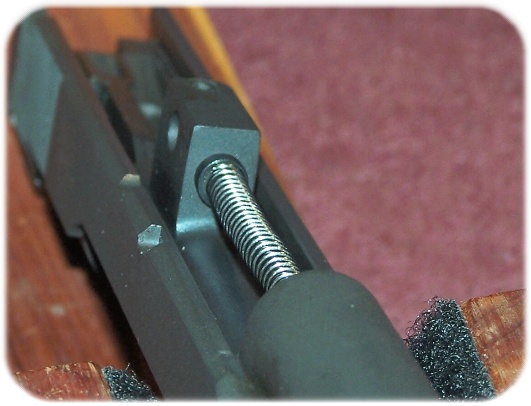
Guide Rod Base Position in Barrel Lug
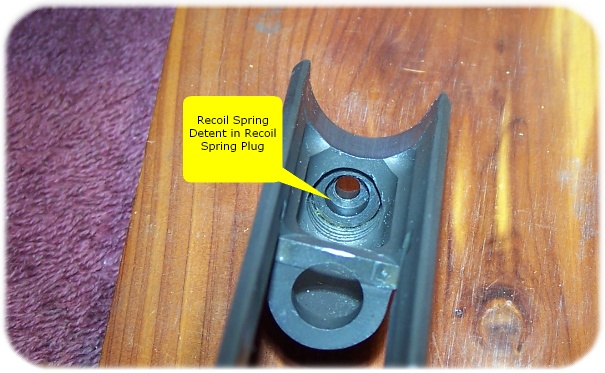
Recoil Spring Detent in Recoil Spring Guide Plug

Inserting the Recoil Spring and Guide Rod
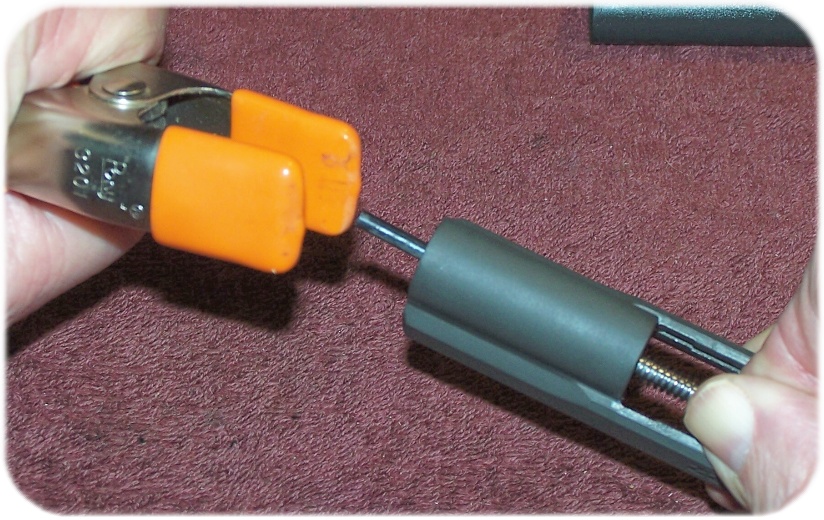
Preparing to Clamp the Recoil Spring Guide
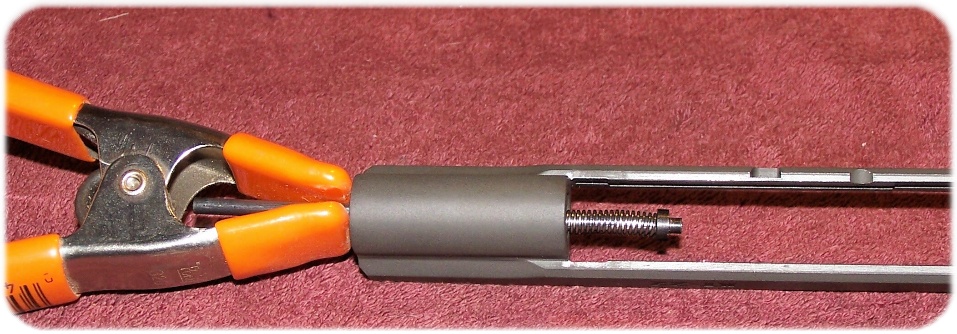
Recoil Spring and Recoil Spring and Guide Rod Fully Clamped and Supported
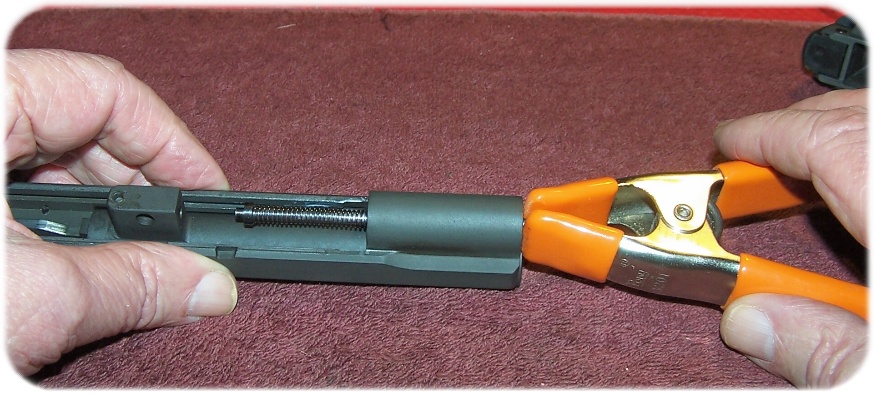
Release Clamp Pressure Slowly and Guide Recoil Spring Guide into Place in the Barrel
![]()

